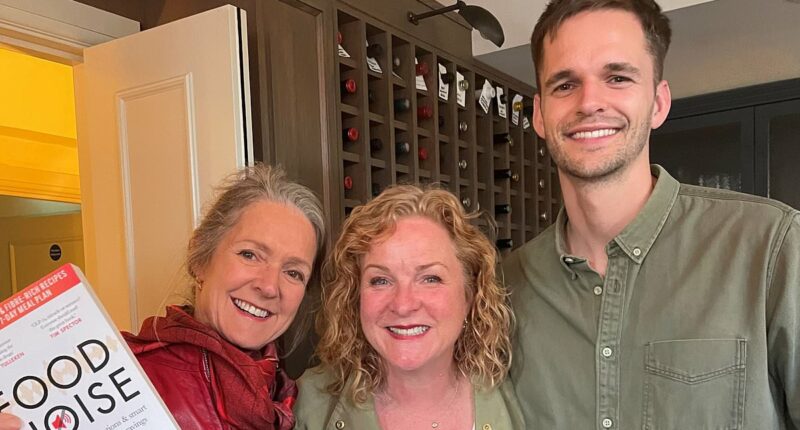Share this @internewscast.com
The sudden surge in the cost of weight-loss injections has forced thousands to reconsider their approach to achieving a leaner body. Many find themselves contemplating a return to traditional dieting, battling once more with the constant temptation of food.
I can personally attest to this dilemma. After losing two stone this past year with the help of Mounjaro, which improved both my health and appearance, the sudden and steep rise in price made it difficult to justify continuing its use to maintain my weight.
The UK’s health authority, NICE, warns that four out of five individuals who discontinue these medications are at risk of regaining the weight they previously shed once their prescription finishes.
This poses a concern for the NHS, as it starts to provide these injections to the most in need. However, it’s also a considerable issue for the approximately 1.5 million Britons, including myself, who have been funding their own prescriptions privately.
For those of us using these injections, a strategy to maintain weight effectively is essential. As a health journalist, I’ve delved into various diets over the years, carefully examining every nutrition and fitness trend.
I collaborated closely with the greatly missed Dr. Michael Mosley and his wife, Dr. Clare Bailey Mosley, on the popular Fast 800 books. Last year, I was asked to work with their son, Dr. Jack Mosley, in crafting his book, Food Noise, which explores the advantages and disadvantages of GLP-1 weight-loss medication.
In fact, it was Jack’s highlighting of emerging research which is fast showing these jabs have health benefits beyond their weight-loss capabilities, that switched me on to the idea of taking GLP-1s myself.

Louise Atkinson worked with Dr Jack Mosley – the son of the late Dr Michael Mosley and his wife, Dr Clare Bailey Mosley – on the writing of his book, Food Noise
Despite their obvious success, Jack’s greatest concern was the way jabs were being dispensed by online pharmacies with ZERO supporting advice about diet and exercise.
Because the GLP-1 drugs suppress your appetite, users are at risk of nutritional deficiency by skipping meals, or making poor food choices,’ he told me.
‘You can’t squander your meagre appetite or calorie allowance on fatty or carb-heavy meals, which are more likely to trigger side-effects such as nausea or heartburn.
‘When you’re eating much smaller quantities, you have to really focus on getting enough protein to protect your muscles and enough fibre to offset the way the medication slows the digestive system.’
So, cleverly, Jack has woven his father’s tried-and-trusted Fast 800 principles into a framework for healthy eating for those taking GLP-1 medication. Last month, he joined his mother, Clare, in launching a new incarnation of the Fast 800 online programme (thefast800.com) with a GLP-1 twist.
Called The Very Fast 800 High Fibre, this online plan claims to provide an adaptable road map for healthy weight loss and weight maintenance for those taking GLP-1s. It also looks like a pretty timely resource if you’re not jabbing but just keen to make the most of the 12 weeks until Christmas to supercharge your health and slim down for the festive party season.
The GLP-1 fast 800
When I started taking Mounjaro back in January, I followed Jack’s advice to make sure all my meals were focused on maximising nutrition and I lost weight steadily – around a pound a week, dropping from 13st to 11st (I’m 5ft7in).
I’m delighted. I’ve never felt healthier and I desperately don’t want to regain that lost weight.
But without the suppression from the jabs and food noise coming back, I know I’ll struggle to limit my food intake.
The principles of the Fast 800 GLP-1 plan are simple. While you’re taking the jabs, you make the most of the appetite suppression to keep your calorie intake at around 800 to 1,000 per day (this is the ‘fasting’ phase known for its rapid weight-loss success).
Then when you reach your target weight or you are coming off the jabs, you slide into the second phase which demands a little willpower and self-control to stick to 800 to 1,000 calories – but only for two or three days a week (in a nod to Dr Michael Mosley’s familiar 5:2 diet).
The idea is the rest of the week you increase your portion sizes but stick to a healthy Mediterranean- style, lowish carbohydrate diet.
Considerable research has shown the Mediterranean diet – packed with salad, vegetables, wholegrains, legumes and olive oil with fish and meat in moderation – is optimal for health, longevity and sustained weight maintenance.
But don’t fall into the trap of thinking you can eat the sort of quantities you used to enjoy. If your body weight has dropped by 20 per cent, your consumption needs to drop accordingly.
You can always throw in the occasional 800 to 1,000 calorie ‘fast day’ to nudge the scales back into line if the numbers start to creep up.
One of the reasons the original Fast 800 plan was so successful was Dr Clare Bailey Mosley’s recipes and meal plans, which were packed with the protein and healthy fats research shows we need to steady blood-sugar levels and keep hunger at bay.
On the new GLP-1 programme, those recipes have been tweaked again to ensure you get at least 60g of protein per day to protect your muscle, but also 20-30g of fibre in the form of salad, vegetables and pulses to ensure maximum nutrients and to protect against the dreaded constipation that blights so many GLP-1 users.
We’ve also been given an exclusive selection of recipes.
In an ideal world, Jack says, everyone on the jabs would take advantage of the appetite suppression to establish healthy new eating patterns such as this (in terms of small portion size, limiting treats, snacking less, reducing alcohol consumption) which they can carry through to help them maintain the lost weight when their jab regime ends.
‘If you don’t change the way you eat, you are more likely to experience uncomfortable side effects, you will lose muscle and you’re more likely to regain any lost weight when you stop,’ he warns.
This conviction is backed by research (including a 2015 study in Stanford, California) which shows teaching people ‘stability skills’ before they try to lose weight can boost chances of long-term success afterwards.
Studies (such as one by UK researchers published in 2021 in the journal Appetite) also show healthy habits can help maintain weight loss because they are less likely to be affected by temptation and fluctuations in motivation.
The bonus for anyone ‘freestyling’ on this diet plan without jabs is that focusing on smaller meals high in protein, fibre, healthy fats and low in carbohydrates will keep you feeling fuller for longer.
This makes the plan good if you’re dieting without medication or just to shape up before Christmas.
Now try these delicious recipes
Mixed berry breakfast

Serves 1, 269 cals, 10.3g protein, 6.1g fibre
- 100g plain full-fat Greek yoghurt
- 10g chia seeds
- 10g whole rolled oats
- 10g walnuts
- 40g mixed berries, fresh or frozen
Combine all ingredients, in layers if you like.
Non-fasting day? Double the portion.
Warm lentil and lamb salad

Serves 1, 392 cals, 38.2g protein, 6.4g fibre
- ½ beetroot, peeled and grated (approx 50g)
- 1 tbsp apple cider vinegar
- Sea salt (to taste)
- 150g lamb fillet, trimmed of fat
- 2 tsp olive oil
- 1 tsp dried oregano
- Black pepper (to taste)
- ¼ onion
- ¼ x400g tin lentils, drained and rinsed
- 30g rocket
1. Make a quick pickle by pouring the apple cider vinegar over the beetroot with a little salt. Stir and put in the fridge.
2. Rub the lamb with 1 tsp of oil (per steak), oregano, salt and pepper. Heat a frying pan on high and cook the lamb for about 4 minutes per side, or until cooked to your liking. Put it on a plate and cover with foil.
3. Reduce the heat to medium, add remaining oil to the pan followed by the onion. Cook for 5-6 minutes until caramelising, then add the lentils for a further 1-2 minutes until warmed.
4. In a bowl, toss the rocket with the beetroot and lentil mixes. Thinly slice the lamb, serve on salad. Non-fasting day? Add cooked quinoa or roasted root vegetables.
Mushroom Stroganoff

Serves 1, 280 cals, 10.9g protein, 16.1g fibre
- ½ tbsp extra virgin olive oil
- ¼ onion, peeled and diced
- 1 tsp ground paprika
- 1 garlic clove, minced
- 200g button mushrooms, choose an assortment, cleaned and sliced
- 70ml vegetable stock
- 2tsp tamari sauce
- 90g broad beans, podded, fresh or frozen
- ¼ cauliflower, cut into florets
- ¼ broccoli, cut into florets
- 50g plain full fat Greek yoghurt
1. Heat the oil in a frying pan and sauté the onion for 3-4 minutes. Stir in the paprika and garlic and cook for a further minute.
2. Add the mushrooms and continue to cook, stirring frequently, for 4-5 minutes.
3. Pour in the stock and tamari, bring to the boil and then simmer for 4-5 minutes.
4. Steam the broad beans, cauliflower and broccoli for 5-6 minutes, until tender.
5. Take the mushrooms off the heat and stir in the yoghurt. Season to taste.
6. Serve Stroganoff with steamed veg.
Mediterranean fish tray bake

Serves 1, 342 cals, 25.6g protein, 6.8g fibre
- ½ red onion, cut into wedges
- ½ red pepper, cut into 2cm chunks
- ½ courgette, cut into half moons
- 1 tomato, quartered
- 1 tbsp extra virgin olive oil
- Sea salt
- 100g firm white fish fillets (one fillet per serving)
- Black pepper
- 20g pitted black olives
- ¼ lemon, juice
1. Preheat the oven to 180C/gas mark 6.
2. Line a baking tray and scatter the onion, pepper, courgette and tomato into a single layer. Drizzle with the olive oil, season and pop in the oven for 20 minutes.
3. Nestle the fish among the vegetables, skin side down if they have it, and season with black pepper. Scatter olives over the tray and squeeze over the lemon juice (more so on the white fish fillets).
4. Return the tray to the oven for about 10 minutes – until the fish is cooked through and the veggies are tender.
5. Serve with fresh salad greens and an extra wedge of lemon.
Cheesy veggie eggs

Serves 1, 360 cals, 26.3g protein, 8.2g fibre
- 1 tsp olive oil
- ¼ red onion, finely diced
- 1 garlic clove, minced
- 50g mushrooms, sliced
- ½ green pepper, diced
- 50g spinach
- ½ x 400g tinned diced tomatoes
- Pinch of dried oregano
- 2 large eggs
- 30g mozzarella cheese, grated
- fresh parsley, chopped
1. Heat olive oil in a non-stick frying pan over medium heat and add the onion and garlic. Cook for 2-3 minutes until softened.
2. Add mushrooms and pepper, cooking for 3-4 minutes until they start to brown. Stir the spinach in until wilted.
3. Pour in tinned tomatoes, season with salt, pepper, oregano and any other herbs and spices you like. Simmer gently with the lid off for 5 minutes to reduce slightly.
4. Use a spoon to create two spaces in the sauce. Crack an egg into each well. Cover with a lid and cook over low heat until egg whites are set (about 6-8 minutes). For firmer yolks, cook longer.
5. Sprinkle cheese over the eggs and sauce. Cover again for 1-2 minutes to melt the cheese.
6. Top with fresh parsley and a squeeze of lemon juice
Non-fasting day? Serve with some wholemeal, rye or sourdough toast.
Lentil spinach dhal
Serves 1, 249 cals, 14.1g protein, 6.6g fibre
- 1 tsp extra virgin olive oil
- 1/2 onion, peeled and diced
- 1/2 red chilli, finely chopped
- 1/2 tsp ground cumin
- 1/4 tsp ground turmeric
- 40g dry red split lentils, rinsed well
- 125ml vegetable stock
- 50g spinach leaves, chopped
- 1/4 lemon, juice
- fresh coriander, chopped
- 10 g plain full fat Greek yoghurt
1. Heat the olive oil in a frying pan over a low heat. Add onion and cook for 4-5 minutes, or until the onion is soft. Add the chilli, cumin and turmeric and cook for a further 2 minutes, stirring.
2. Add the lentils to the pan and turn up the heat. Fry the lentils for a few minutes and then pour in the vegetable stock. Turn the heat down and leave the lentils to simmer for approximately 15 minutes, or until the lentils are swollen and the stock has been absorbed, stir occasionally.
3. Add the spinach and cook, stirring, for a further 2 minutes. Season to taste.
4. Serve topped with yoghurt, and lemon juice, then sprinkle with coriander.











